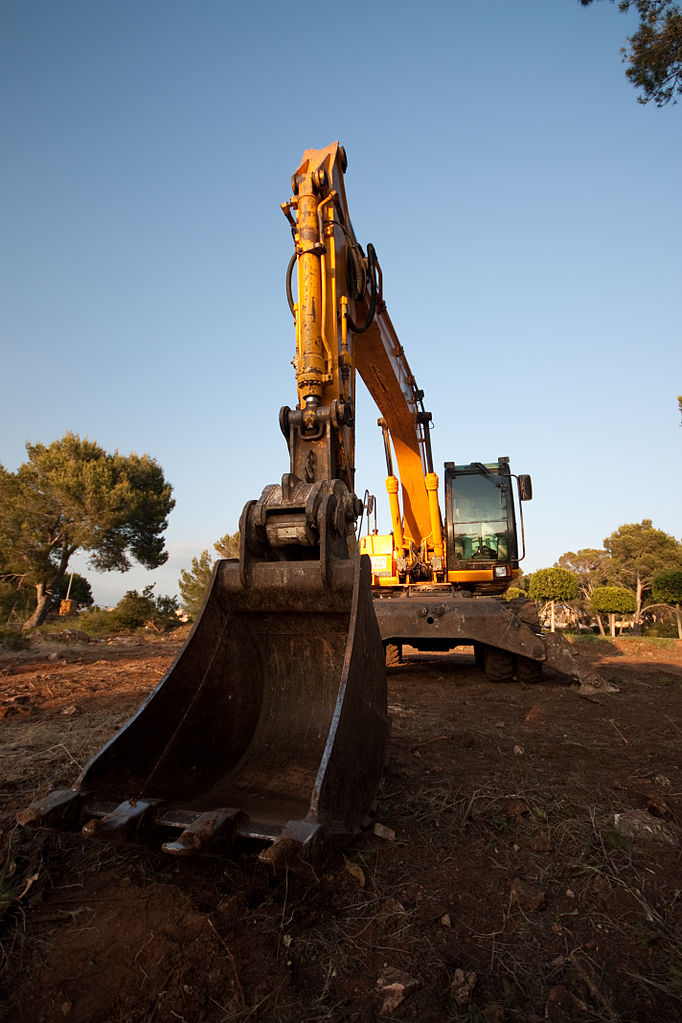
Is bigger better?
image source

Is bigger better?
image source
Robots move. And they move objects around the world. To make something move you need exert a force on it. Newton's mechanics states that a force on an object changes its velocity, and without applied forces it just keeps moving the way it was. Combined with the universal law of gravitation (also Newton's), this explains the motions of the planets beautifully. Down on earth we need to deal with pesky frictional forces which bring a moving object to a halt when you stop applying force to it, or soon thereafter. Basically without constantly applied force, everything stops moving.
Actuators are the generators of the forces that robots employ to move themselves and other objects. In physics, the definition of work is a force applied over a distance. All actuators are thus energy consuming mechanisms that convert various forms of stored energy into mechanical work. Electrical motors are a familiar example.
Robots by definition deploy some form of adaptive control to their activity. In modern practice the control "logic" is typically implemented using computer hardware, or sometimes simpler discrete electronics. Historical automation systems made use of several other "computational" technologies including mechanical systems, pneumatic and hydraulic fluidics, and relay logic. The speed, computational power, low cost, compactness, and reliability of digital electronics has rendered other control modalities obsolete with the exception of a handful of extremely simple and reliable mechanical and electromechanical systems (for example speed limiters on inexpensive engines are still often implemented mechanically.)
To be of use to a robot, an actuator must interface to the control "computer". Because modern control logic is nearly universally electronic, we focus on electronic/electrical interfaces. Now a naked motor cannot usefully be attached to a microprocessor chip. This illustrates the fact that control interfaces usually involves several levels of signal translation and amplification.
Understanding and exploiting the interface chain is often the most difficult part of employing an actuator in a robot. Actuators intended for robotic application hardly ever come "naked". Most have some sort of control interface already built in or available as a custom "driver" circuit. These range from relatively simple analog interfaces to full-blown integrated microprocessor systems running complex software. These interfaces may or may not be directly connectable to a host microprocessor chip. Most are not. This can simplify life as it means that robot designers do not need to work with naked microprocessors, but it also brings sensitivity to host OS and all the associated "software rot" problems.
At the highest level, some actuators are connectable to standard high-level computer system interfaces such as USB, Firewire, or even IP. Such high-level interfaces require driver software specific to the operating system on the host computer, and this needs to implement an API if the robot is to be programmed in any flexible manner. They also suffer from unpredictable fractional-second or even multi-second delays due to interaction with the OS and multiple levels of internal translation up and down the protocol stack. They should not be used to implement feedback control.
At a slightly lower level, some actuators provide a digital control interface that can be memory mapped into the address space of a host computer. A system-specific driver is still needed, but the API reduces to reading and writing memory locations to send commands and receive feedback information. A slower variation uses the native system API to communicate byte-level data over a serial line. These systems can be much faster than those employing top-level protocols, but may still suffer occasional unpredictable delay due to OS interrupts. Some operating systems may be able to provide guarantees about such delays.
Lower still are systems intended to be driven by embedded microcontrollers.
These may accept input in the form of digital control pulses of
specified length, or sometimes analog voltages, though the latter
may require separate amplification circuitry as the output power of
microcontrollers is generally limited.
These systems are suitable for implementing fast feedback control as
long as the microcontroller is carefully programmed.
Classic electric motors convert electrical energy into rotational
mechanical energy.
Most of them use electromagnetics to accomplish this.
Practical motors date only from the late 19th century,
with development delayed primarily because there was no practical
source of electric power until the first power grids driven by demand for
electric lighting were deployed.
The first commercially successful motors showed up in the 1880s.
Explosive development followed, and by 1900, most of the basic
design principles had been discovered.
Motors can be classified both electromagnetically and from a control
standpoint. For robot building, we will be most concerned with
the control classification, but it is worth knowing a little about
the electrical classification as well.
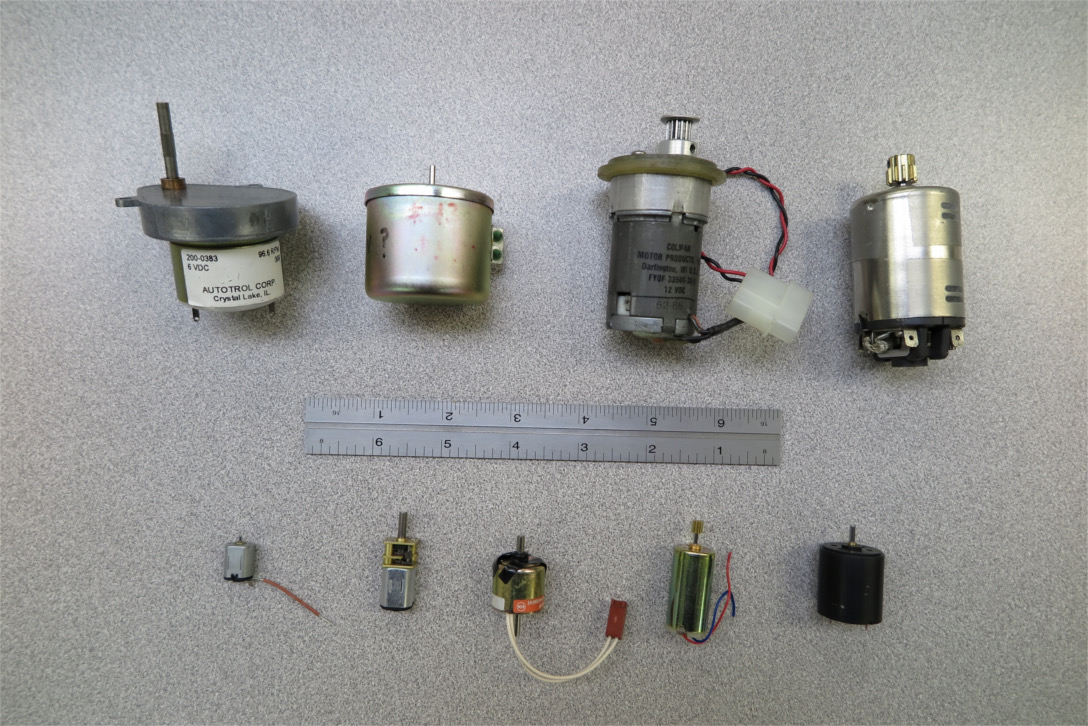
Small DC brush motors.
1 and 3 in top row have attached gearboxes.
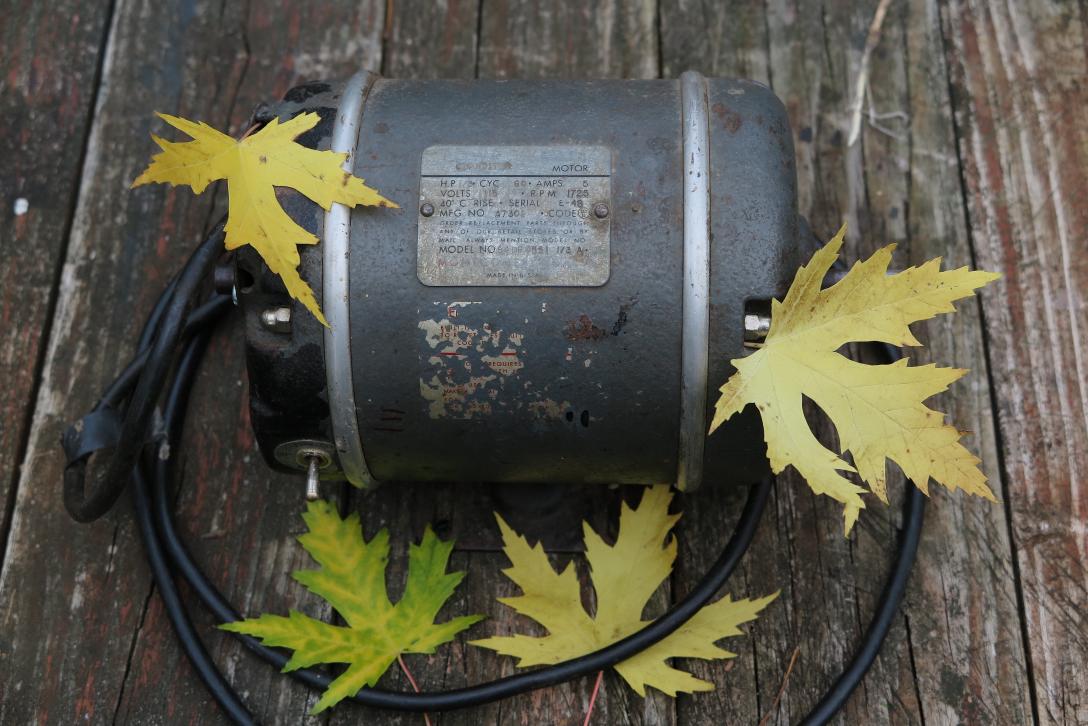
Old AC induction motor
The simplest basic design is the brushed DC permanent magnet motor. Basically a set of electromagnets known as an armature is arranged around a rotor and placed between the poles of a permanent magnet. A set of sliding contacts known as a commutator is also arranged around the axle. These rotate past the brushes which supply current to the electromagnets at just the right position so that they are always pulled towards (or pushed away from) the permanent magnets in the direction of rotation. Under a given load, the speed increases with the current/voltage giving a reliable method of speed control.
Reversing the current/voltage in a permanent-magnet motor reverses the direction of rotation. The permanent field magnets can be replaced with an electromagnet. This version does not reverse with the current, making it usable with AC. Such motors are often used in high and variable-speed household appliances such as vacuums, blenders, and mixers. They tend to have some vibration at the frequency of the supply. Brushed motors generate sparks as the commutator opens and closes the rotor coil circuits, and should never be employed in explosive atmospheres. Also, the brush contacts eventually wear and need to be serviced or replaced.
Wikipedia on brushed DC motors
A second major class is induction motors, also known as asynchronous AC motors. These run on AC, as the second name suggests, and have a narrow RPM range at which they are designed to operate. This is typically slightly below the maximum "free-running" rpm, which is where the motor will operate without load, hence the "asynchronous" label. Increasing the load slows the motor a bit, and this is how power is drawn from it, but if the motor is slowed significantly below the free-running velocity it will lose torque, stall and not function effectively, though it may draw enough current to blow fuses (or burn itself out if unprotected) Because of this, many induction motors have special starting arrangements built in.
The basic principle of operation is to use the AC current in conjunction with a carefully designed set of stator coils to set up a rotating magnetic field inside the motor in synch with the AC frequency. This moving field induces currents in the rotor coils in such a way that it is dragged around with the rotation by the interacting magnetic forces. Note that this dragging occurs in any conductor placed within a moving magnetic field as a consequence of the laws of electromagnetism. The trick is to design the coils to maximize motive power while minimizing resistive losses. A great advantage of induction motors is that there are no brush contacts to spark or wear out.
Most large industrial motors are induction motors, and they are also common in low-power household appliances such as fans. The speed of rotation can be varied by changing the AC frequency and this can be done with sufficient circuit complexity, but in general induction motors should be considered to be fixed-speed power sources. Single-phase induction motors use the rotor field to supply a rotational component to the stator field, which would otherwise simply oscillate. They frequently use a capacitor produce an offset phase for startup. There are also tricks employing assymetric coil design used for the same purpose.
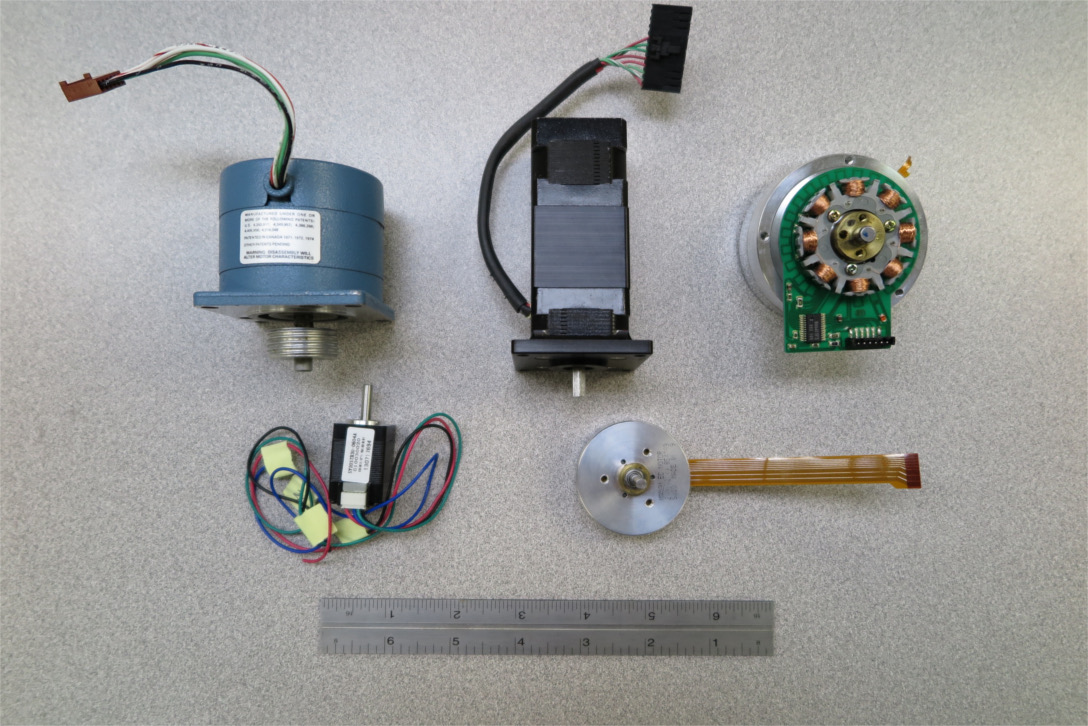
Stepper motors
Synchronous AC motors and steppers are electromechanically similar and often interchangable. The different terms refer to different modes of use. In synchronous AC use, the motor is a source of continuous rotation that is synchronized to an AC power source. Used as a stepper, the motor is advanced from one discrete position to another, usually under some sort of digital control. Most use in robotics is as steppers, so we will concentrate on that application.
A stepper motor has its revolution divided into a discrete number of stable positions or steps (often 200). This characteristic is generally implemented directly at the electromechanical level using rotors and stator windings with many poles. The primary advantage of a stepper is the simplified control interface it presents. Abstractly this can consist of just two commands that advance the motor one step forwards or backwards combined with a default "do nothing" state where the motor holds its current position.
Electromechanically, stepper motors utilize four or more configurations of field coils with only one configuration active in any stable position. In practice the configurations are not usually separate, physically disjoint coils, instead each configuration is formed by running currents in various directions through several of the physical coils of the motor. There is a circular sequence associated with the configurations such that if the motor is in a position associated with some configuration, energizing the next in the sequence moves the motor one step forward. Energizing the previous configuration moves the motor back one step. The sequence of configurations is generally repeated several times during a revolution, for example, a 200 position stepper with 4 coil configurations repeats the sequence 50 times during one revolution.
Most steppers can be placed in intermediate positions by partially energizing adjacent configurations. When done so as to discretely subdivide each step this is termed microstepping. From an abstract control point of view it is just a longer sequence of coil activation configurations where now the magnitude as well as the sign of the coil currents is varied. In the limit, a stepper can be smoothly driven by phased sinusoids in the field coils in which case it is simply acting as a synchronous AC motor.
A variety of internal geometries are used to implement stepping functionality. The rotors may consist of permanent magnets, high-permeability magnetic material (variable reluctance design), or both (hybrid design). One common design uses permanent-magnet rotor with alternating N and S poles, inside an interlaced pair of multi-pole field coils offset from each other by half the rotor pole spacing. If we label the field coils A and B, and suppose that the current through each coil can be positive (+), negative (-) or off (*), then configuration 1 is (A+,B*); configuration 2 is (A*,B+); 3 is (A-,B*); and 4 is (A*,B-). The advantage to re-using the physical coils in different steps is there is less "dead metal" at any given position and hence a more compact and powerful motor.
Stepper motors are sometimes described as 2-phase, 3-phase, etc. This refers to the number of physically distinct field coils. Most common small steppers are 2-phase devices, but higher phase motors are sometimes found, especially when smooth operation is desired. A 2-phase stepper may have 4, 6, or 8 wires. The 6 and 8 wire versions implement something called uni-polar winding (as compared to bi-polar). Essentially this provides a second physical winding around each coil in the opposite direction which permits polarity to be reversed without reversing currents in a wire. This allows simpler driver circuits, but at the cost of increased dead metal.
Modern motors employ a large variety of designs.
The use of silicon either for diodes or non-mechanical switches
greatly increases the motor-designer's toolkit.
There are brushless DC motors and variable speed induction motors
and silicon commutated motors with permanent magnet rotors.
There are sealed motors for explosive atmospheres and underwater or vacuum
operation.
Motors can be obtained for ultrahigh speeds or torques.
Others can run continuously for years with no maintenance.
If you want a special-purpose motor, somebody probably makes it.
But it may cost you.
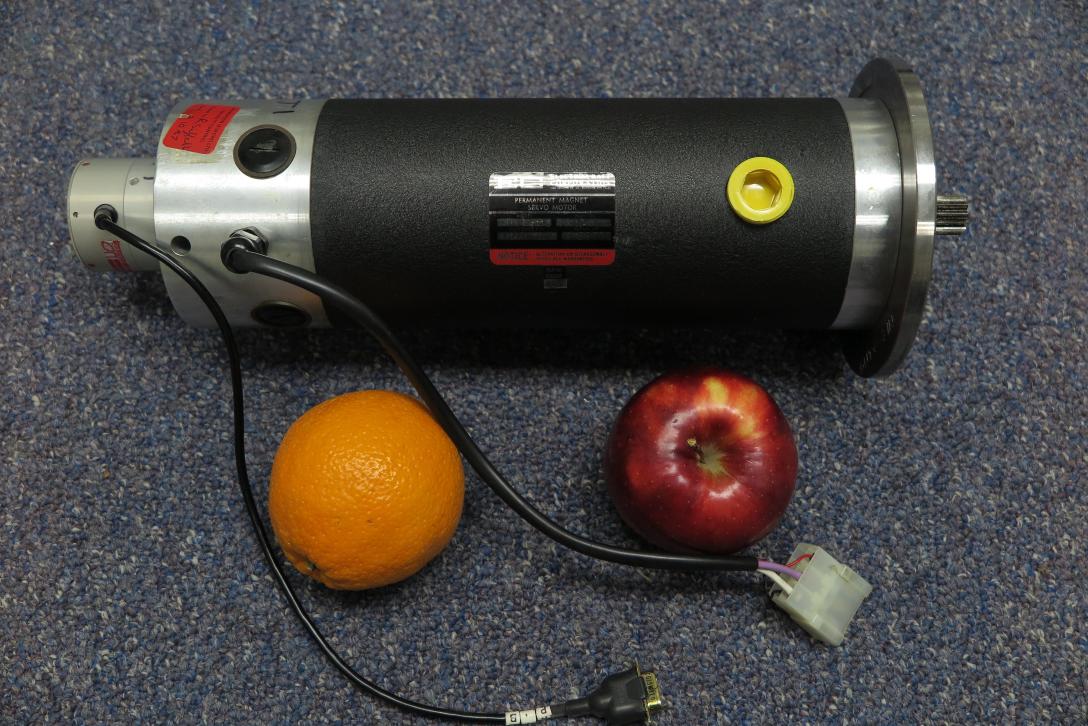
Large servomotor from a Puma 760 robot arm.
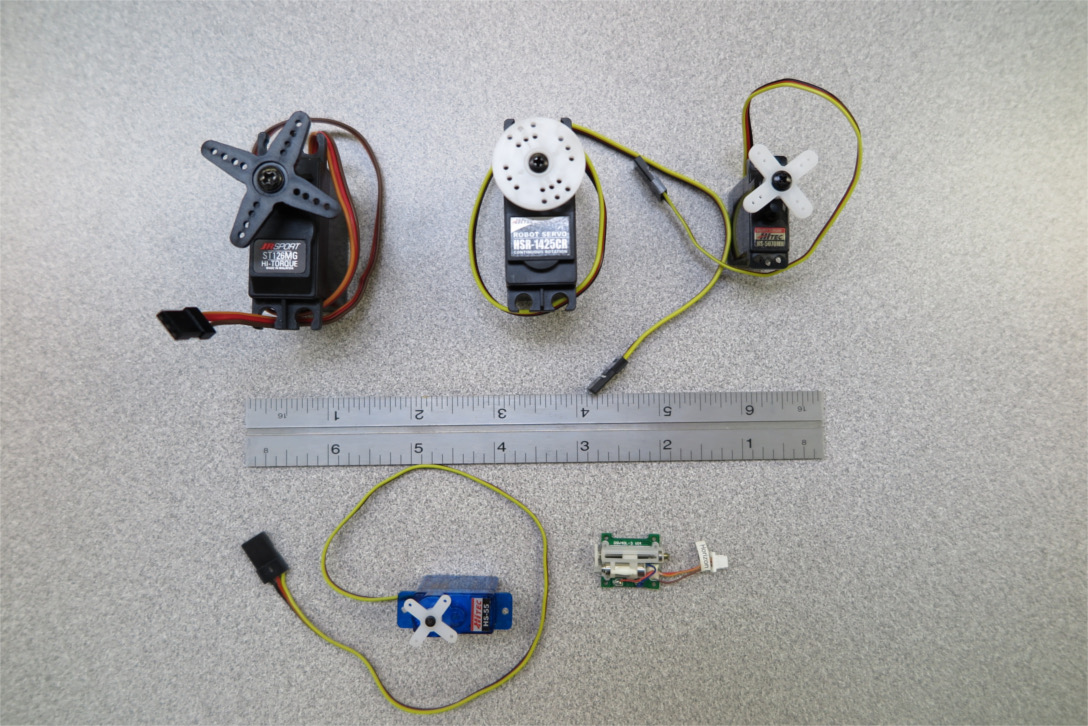
Small RC servos
A servomotor is a motor with an interface that takes a desired position and sometimes velocity as input, and moves to that position. To do this, the motor must include a controller that can measure the current position of the motor, compare it with the desired position, and adjust the electrical input to the motor so that it moves towards the desired setting (possibly at a desired velocity). It should insure that the motor reaches the desired position in a well regulated manner, generally without jerking, oscillating, overshooting excessively, or reacting badly to an unexpected disturbance. Exactly how to do this is the subject of control theory, which can be quite complicated. The beauty of a servo-motor is that a big chunk of the low-level control is done for you.
The underlying motor can be of any type, though DC motors of various sorts are most common. The motor may include a gearbox or other transmission already attached, in which case it is sometimes refered to as a servomechanism rather than just a motor. Position can be sensed by a variety of methods from simple potentiometers, to pulse generator/counters, to full digital position encoders. Some sensors must be zeroed at startup.
Depending on the controller, desired position can be indicated by an analog voltage input, the length of a signal pulse, a digitally encoded number, possibly transmitted using a serial protocol, and numerous other possibilities. The controller may provide variously encoded return values including the current actual position, a current residual error, a signal on completion; or it may run completely open loop with no return. The servo may have the capability to adjust offsets, gains, and other internal parameters electronically.
Servomotors can be quite expensive and complex. However, a commercial line of small, lightweight, inexpensive servomechanisms with a standard interface has been developed for RC model airplane hobbyists. These have been widely used by robot experimenters. The mechanisms consist of a small DC motor attached to a premade gearbox. A potentiometer provides position feedback to a simple electronic control interface. The control interface is via a pulse-width modulation (PWM) scheme with a nominal repitition of 50 Hz (a control pulse every 20 ms). The most common standard uses pulses between 1ms and 2ms, with 1.5ms indicating the center position, and 1ms and 2ms low and high extremes. This scheme lends itself well to simple microcontrollers, e.g. Arduino boards, which have sufficient output power to connect directly to the servo control lines.
More on RC servos from Wikipedia
A stepper could theoretically be used by controlling individual power drivers for each coil directly from a microcontroller. This approach has the disadvantage that a program bug could order a non-canonical state, such as all coils on at once. Depending on the design, this might damage the motor, the power electronics, or if you are lucky, just blow a fuse. Hence stepper motors are usually equipped with separate, hard-wired driver electronics that prevent non-canonical activation and provide a simplified control interface. One common interface takes two digital inputs. One serves as a direction indicator, and the other causes the motor to move one step each time a pulse is provided on the line.
Abstractly, a stepper is moved from one position to another by positioning it sequentially at each step in between. In this abstraction the motor halts completely after each step. Realistically, if this were done at speed, the required torque would exceed anything the motor could provide, and the vibration would be horrible. To run a stepper motor at reasonable speed we need to allow it some ability to "coast" between steps when moving quickly. This can be done by limiting the strength of the stepping field, or by employing microstepping. Both options can reduce the available torque and decrease available acceleration. A smarter driver can help by changing the strength of the stepping field if acceleration is needed.
Another issue is that torque increases with current in the coils, but coil inductance tends to oppose rapid current change. This makes it difficult to rapidly apply force needed to move to the next step. The problem can be ameliorated by spiking the voltage at the start of a step, typically to several times the "rated" voltage of the motor, to quickly obtain the desired current, and then backing off to maintain it. This also requires a smarter driver. So we don't get to avoid the control problems of servos completely. However, the stepper abstraction is a useful interface for many applications. And if we can buy the right driver, the hard control will be done for us.
Despite driver smarts, realistic applications will generally require that the motor be run faster than it can be stopped (or started) in a single step. If we just stop issuing control pulses to a rapidly running stepper, the motor will overrun and stall. So some attention must be paid to velocity and acceleration at the micro-controller level. As usual there is no really free lunch.
The primary advantage to steppers is that the control logic can, in principle, know exactly where the motor is just by counting the commands it has sent without the need for external position encoders. The down side of this is that if the stepper stalls or skips due to attempted too-rapid acceleration or external forces that exceed the holding torque, then the controller has no direct way of knowing what has happened, and all subsequent positions will be displaced from where the controller thinks they are. A related problem is that the controller has no way of knowing where the motor is when the system is turned on. Thus an initialization procedure is usually required. Some drivers may signal when a stall has occurred, in which case the situation can be rectified by re-initialization.
Datasheet for 3967 stepper driver chip
If you want some idea of what is actually involved in driving
a stepper, look at this (hint, it's not just an H-bridge).
A solenoid in its simplest form is a coil that pulls a rod of magnetic material (e.g. iron) towards its center when a current is passed through. If the rod is magnet, current passing one direction will pull the rod towards the coil center and current in the reverse direction will push the rod away from the center. In both cases there is an equilibrium point when the rod is centered in the coil. In the repulsive situation, the equilibrium is unstable. By having an uncentered rod act against a spring, a linear actuator can be produced where the displacement depends on the coil current, though not, unfortunately, in a very linear way.
For constant coil current, the force on the central rod depends on position in a very non-linear way. The force is zero on a centered rod, and rises somewhat linearly as the rod is withdrawn, to a maximum somewhere around the point where the trailing end of the rod reaches the end of the coil. From there, the force drops very rapidly towards zero. The basic solenoid can be modified by changing the length and shape of the central rod and surrounding the coil by magnetic material in various arrangements.
Because of the generally non-linear relation between forces and geometry except over small distances, solenoids are most familiar as "bang-bang" actuators that take one of two positions. Relays (essentially electromagnetic switches) are a well-known example. The solenoid valves that turn water on and off in automatic washing machines are another (these are actually two-stage hydraulically actuated devices where only the initial, low-force stage is magnetically actuated). Solenoids are also sometimes used to bring transmission elements into different alignments, the best-known example being the engagement of an (old-style) automobile starter motor. Small solenoids have been used in pin-action dot-matrix printers
The greatest us of solenoids in robotics is probably in relays. However, they can also be useful to open and close simple ports, to actuate locking mechanisms, for simple push or pull effectors, and other low-power binary positioning. If your robot is going to spray liquids, solenoid valves might be useful. Because the forces are highly non-linear, solenoids do not make good prime movers over any significant distance. The friction on the central rod can be highy variable with position, and a poorly designed actuator may bind or jam.
There are a large number of variants of the basic solenoid design which might be summarized as single-coil actuators. Rotational variants can be made. Sometimes the coil rather than the magnet moves. A solonoid combined with a positional encoder and feedback control can be used as (short range) continuous position effector. If mounted on well designed bearings, such magnetic actuators can be extremely fast and precise. The mechanism that positions read heads over spinning disks in magnetic hard-drives (within thousanths of an inch in milliseconds) is driven by a single high-current coil in a strong magnetic field and can thus be viewed as a kind of solenoid actuator.
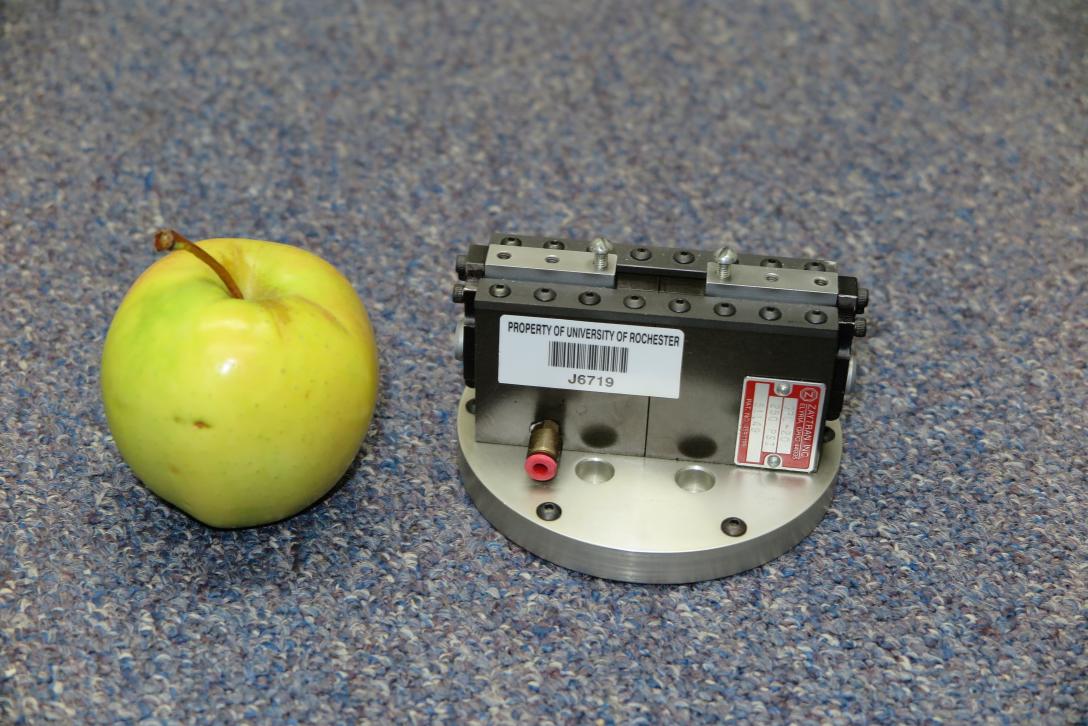
A pneumatic gripper
Pneumatic actuators derive their energy from a compressed air supply. The canonical example is the pavement-breaking jackhammer. The principle advantage of pneumatic actuators is that they are able to generate very high power in a small volume, especially compared to standard electrical actuators. They are also capable of very rapid directly-driven movement. Pneumatics carry no risk of electric shock, and do not generate electric sparks, which makes them more suitable for use in wet environments and in the presence of flammable gasses than simple electrical equipment.
A significant disadvantage of pneumatics is that the power connections consist of pressure hoses, which are generally bulkier and stiffer than electrical cords. Another drawback is that a nearby compressor is usually required to produce the compressed air as there is no widespread pneumatic distribution infrastructure. In most situations, compressed air is significantly less cost-effective than electricity for transmitting energy. The actuators themselves are often inefficient in terms of the fraction of the theoretical pressure energy actually converted into mechanical work. Since this pressure energy is less than the energy consumed to produce it, the overall efficiency may be quite low. These losses, combined with the relatively low energy density of compressed air tanks compared with chemical fuels (e.g. gasoline) have prevented the development of practical pneumatic vehicles.
Because of the high power density and relatively low cost of manufacture, a line of inexpensive pneumatic tools aimed at DIY craftsmen and home repair/remodelling contracters has become available over the last several decades. Pneumatic versions of most hand power tools, including drills, saws, grinders and sanders as well as impulsive tools such as nail drivers are available. They generally operate off an air supply around 100 psi.
The high available power density coupled with high speed has made pneumatics attractive for some robotics applications. Because compressed air acts as a spring, pneumatic actuators often have built-in compliance. This can make operations such as grasping and manipulation more robust, but it also makes precise control more difficult.
Pneumatic pistons have been much studied as "artificial muscles" for use in legged locomation. These studies have met with mixed success. While the natural springiness and compliance of pneumatics are useful in some phases of legged locomotion, there are other phases where stiff actuation is needed to achieve stability. It is hard to make pneumatic actuators stiff; whereas there are digital control techniques for making stiff motor actuators act complient. Consequently current state-of-the-art legged locomotion is mostly motor-driven. On the other hand, check out this cute/creepy "pneuborn" baby bot from Osaka University's Hosada Lab.
The most likely use of pneumatics for our robots would be for impulsive applications such as jumping or delivering a rapid blow, where electrical systems are unable to provide sufficient power. Even for these, the need to be tethered to an air hose or carry an on-board compressor is a significant impediment.
Wikipedia on pneumatic systems
Well we've all seen those shiny steam-punk bots
(Ray Toh).
No reason we can't actually make one
(Kevin Mowrer).
After all, steam is just like really really hot, wet, compressed air...
Hydraulic systems use pressurized liquids to transfer force and energy to actuators. The pistons on heavy machinery are the most familiar example. A basic hydraulic system consists of the following:
Hydraulic systems have certain similarities to pneumatic ones as both utilize pressurized fluids to produce motion. However hydraulics use effectively incompressible liquids, while pneumatics use compressible gasses. This makes hydraulic systems both very rigid, and capable of exerting extremely large forces. Unlike pneumatics they stop moving immediately when fluid flow is cut off; there is no compressed gas that needs to be bled away.
The very high pressure employed makes engineering hydraulic systems more demanding than pneumatic ones. A small leak in a compressed air system can usually be tolerated. A small leak in a hydraulic system can be disasterous. High-pressure fuids can exit through an invisible pinhole with sufficient velocity to penetrate deep into the human body. This can produce serious injury or death. Blown into the air, such a jet may volatilize into an explosive aerosol. Even just a slow oozing leak around a piston seal is problematic. Hydraulic fluids are often messy, slippery, and may be toxic. Leaking air vanishes into thin air. Leaking hydraulic fluid leaves a sticky trail that is a pain to clean up. Using plain water as a fluid would reduce the mess problems, but has significant drawbacks - it has a low boiling point, accumulates contaminants, rusts steel, supports slimy life forms, etc. - and so is rarely used.
Despite the difficulties, hydraulics are employed in some industrial robots due to their ability to produce very large forces in a compact package. With appropriate servo valves and force and position sensors they can be very precisely controlled. A backhoe is essentially a large hydraulic manipulator. Connected to an automatic control system it would be a large, powerful robot.
We will probably make little use of hydraulics in this class as the
required mechanical infrastructure is large, heavy, noisy, messy,
and expensive.
The actuators themselves must be heavily constructed and sealing parts
made to very precise tolerance.
An exception might be small passive units used for damping or to effect
compliance.
But the image of a giant, earthshaking, hydraulic, walking
robot stomping down the street and over the hills
should be kept firmly in mind.
We could start with two of
these.
Hydraulic machinery on Wikipedia
Piezoelectric materials generate an electric field when deformed and vice versa. The latter property makes them candidates for electrically powered robot actuators. A large number of natural materials, including bone, silk, and wood exhibit piezoelectricity to some degree, but only a few materials have effects strong enough to be useful as actuators. The first piezoelectric materials studied were rigid crystals for which the possible deformation before fracture is small (e.g. a few parts in 1000). Associated electric fields can be thousands of volts/cm. For example, quartz under 40MPa (6000 psi), corresponding to a deformation of about 1 part in 1000 can produce over 20,000 V/cm. Synthetic ceramic piezoelectric materials e.g., lead zirconate titanate can exhibit effects several times as large.
The most familiar use of piezoelectrics is probably the quartz crystal oscillator. Any crystal has a natural mechanical oscillation frequency. If it is piezoelectric, there will also be an oscillating electric field. If this is amplified and fed back into the crystal with an appropriate phase delay, the result is a self-sustaining oscillator with a very stable frequency. A piezoelectric material bonded across one side of a flexible disc will cause the disc to flex in response to an applied voltage. Amplified feedback produces a buzzer at a natural frequency of the of the disc - the familiar electric "beeper" Directly driven, the device becomes a piezoelectric speaker. Hard-driven crystals in direct contact with liquid or solid media can produce intense acoustic waves. This is employed in submarine sonar pingers and (at lower energies) in ultrasonic imaging. Another everyday use is in push-button lighters. Pressing the trigger propels a spring-driven "hammer" into a piezoelectric crystal. The resulting momentary compression produces an electric field strong enough to generate a spark that ignites the lighter fuel.
Piezoelectrics are ideal for producing very small movements under exquisite control. In scanning tunnelling and atomic-force microscopes, piezoelectric actuators are used to produce controlled movements of less than one atomic diameter. For macroscopic motions however, some sort of movement amplification is needed. The most common technique is differential flex actuation, where the piezoelectric material is strongly bonded to a thin beam of elastic material. A small change in the length of the piezoelectric element is thus translated into a much larger lateral flexture of the beam. The energy efficiency tends to be on the low side as does the absolute force produceable, and at scales above a couple of inches there are usually better choices. However, the simplicity of the design makes it possible to produce very small actuators easily and at low cost. Insect-sized robots weighing less than 100 mg have been built using such technology.
A paper on piezo microactutors from the Harvard Microrobotics Laboratory
Wikipedia on amplified piezoelectric actuators
The original shape memory materials were exotic metal alloys, (SMAs) that can be annealed in a particular shape and cooled. The cooled metal can be plastically deformed, but when heated above a transition temperature, returns to the annealed shape. Such metals can also be treated so as to shift reversably between two forms on heating and cooling, with some degree of hysteresis. This odd behavior can be used to produce custom-shaped actuators that are powered by heating the element, often by running current through the metal itself. Certain plastics also exhibit shape-memory behavior.
The best known shape-memory metal is nitinol, an alloy of approximately half nickle and half titanium by atomic ratio (55% nickle by weight). The 50-50 atomic ratio represents an "intermetallic" compound where the alloy is composed of a regular alternating structure of nickle and titanium atoms. This is related to the material's unusual properties. The transition temperature can be selected in a range around room temperature, which makes nitinol ideal for everyday applications. Usually SMA elements are long, narrow forms that permit significant bending. Bulk elements can be used to produce extremely high forces, as much as 100,000 psi.
SMAs have been used for pressure seals and for items such as eyeglass frames where an ability to recover from severe deformation is desired. Because complex geometries and compact form factors can be produced, shape-memory materials have been considered for robot actuation. The primary drawbacks are slow response, especially during the cooling phase, limited size (large objects are difficult to heat and cool), and extreme energy inefficiency (on the order of 1%). Bug-like legged robots a few inches long have been demonstrated. In larger bots, specialized actuators may be powered by SMAs.
Wikipedia on shape-memory alloys
Any material that changes volume significantly under a solid-to-liquid phase change can be used to drive an actuator. The most familiar example is old-tyle automotive thermostats that use the expansion of a wax melting near the desired engine running temperature to drive a piston, which actuates a valve shunting engine coolant to the radiator. The expansion is only on the order of 10%, but it can generate pressures of thousands of psi with just a few degrees of temperature increase. Attached to a motion-magnifying lever or hydraulic system, such actuators can be used to robustly open vents or windows at specified temperatures and in other similar applications. The process is slow and energy inefficient, but there might be robot applications where such actuators would be useful. (Uncovering the solar panel protectors on a robot sleeping through a polar winter anyone?)
Quadcopters and their relatives use propellors to exert controlled forces
against the air. Submarine robots do the same underwater.
Propellors can be fixed, in which case airfoils/rudders or multiple
props at different orientations are employed to change the direction of
the force vector.
Some propellors have adjustable orientation to achieve the same effect.
Force can be varied either by changing the speed of the driving motor,
or by changing the pitch of the propellor blades.
The latter approach is frequently used despite increased mechanical
complexity because it permits much faster variation, and allows thrust reversal
without changing the rotation direction of the motor.
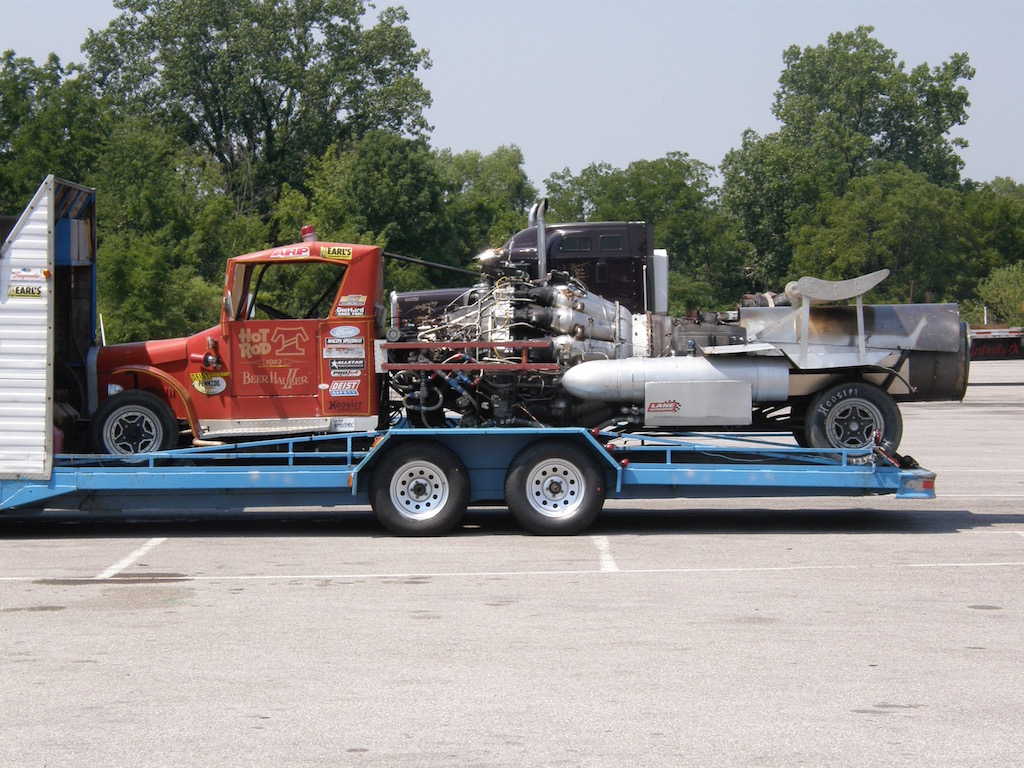
Almost a rocket...
Outer space robots use small rockets or gas jets to manuever when there
is no environment to push against.
In terrestrial applications, compressed air jets are occasionally used
to provide fast reaction forces.
If we use rockets, it will probably be as a primary boost mechanism to
bring a system to high speed rather than for fine control, but you never know.
MHD,
Acoustic,
Artificial Muscles, ...